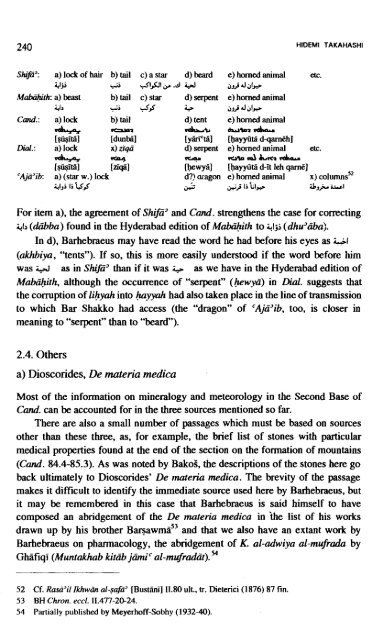doc.pdf
doc.pdf
doc.pdf
You also want an ePaper? Increase the reach of your titles
YUMPU automatically turns print PDFs into web optimized ePapers that Google loves.
Shiw a) lock of hair b) tail c) a star d) beard<br />
&Iji 4;s yS1Sl.p .s icJ<br />
M&i&ith: a) beast b) tail c) star d) serpent<br />
&I3 4;s yS,f G-<br />
Cand.: a) lock b) tail d) tent<br />
+ -3<br />
-<br />
&%<br />
[s@iti%] [dunk] [yhita]<br />
Dial.: a)lock x) ziqa d) serpent<br />
+ =w<br />
[sipia] [s@l bvfd<br />
'Aja'ib: a) (star w.) lock d?) aragon<br />
&lJi Ii 'u,f +-<br />
e) homed animal etc.<br />
392 .J 3%<br />
e) horned animal<br />
e) homed animal<br />
A<br />
[hayyiiB dqarn6hI<br />
e) horned animal etc.<br />
ru* aJ &e* &&A<br />
[hayyOti% d-it leh qarne]<br />
e) homed animal x) co~umns~~<br />
&> li b,+ ibJ+ i u l<br />
For item a), the agreement of Shqa' and Cd. strengthens the case for correcting<br />
413 (dcfbba) found in the Hyderabad edition of Mwith to LIji (dhu'aa).<br />
In d), Barhebraeus may have read the word he had before his eyes as -1<br />
(akhbiya, "tents"). If so, this is more easily understood if the word before him<br />
was &I as in Shifa' than if it was i+ as we have in the Hyderabad edition of<br />
Mabahith, although the occurrence of "serpent" (kwya) in Dial. suggests that<br />
the corruption of lihyah into kyyah had also taken place in the line of transmission<br />
to which Bar Shakko had access (the "dragon" of 'Ajd'ib, too, is closer in<br />
meaning to "serpent" than to "beard).<br />
2.4. Others<br />
a) Dioscorides, De materia medica<br />
Most of the information on mineralogy and meteorology in the Second Base of<br />
Cand. can be accounted for in the three sources mentioned so far.<br />
There are also a small number of passages which must be based on sources<br />
other than these three, as, for example, the brief list of stones with particular<br />
medical properties found at the end of the section on the formation of mountains<br />
(Cd. 84.4-85.3). As was noted by BakoS, the descriptions of the stones here go<br />
back ultimately to Dioscorides' De materia medica. The brevity of the passage<br />
makes it difficult to identify the immediate source used here by Barhebraeus, but<br />
it may be remembered in this case that Barhebraeus is said himself to have<br />
composed an abridgement of the De materia medica in .the list of his works<br />
drawn up by his brother ~aqawma'~ and that we also have an extant work by<br />
Barhebraeus on pharmacology, the abridgement of K. al-udwiya al-mufrada by<br />
Ghafiqi (Muntakhab kit& jhic al-mufradat). 54<br />
52 Cf. Rusa'il Ikhwh al-safa' [Busmi] 11.80 ult, tr. Dieterici (1876) 87 fin.<br />
53 BH Chron. eccl. 11.477-20-24.<br />
54 Partially published by Meyerhoff-Sobhy (1932-40).
















